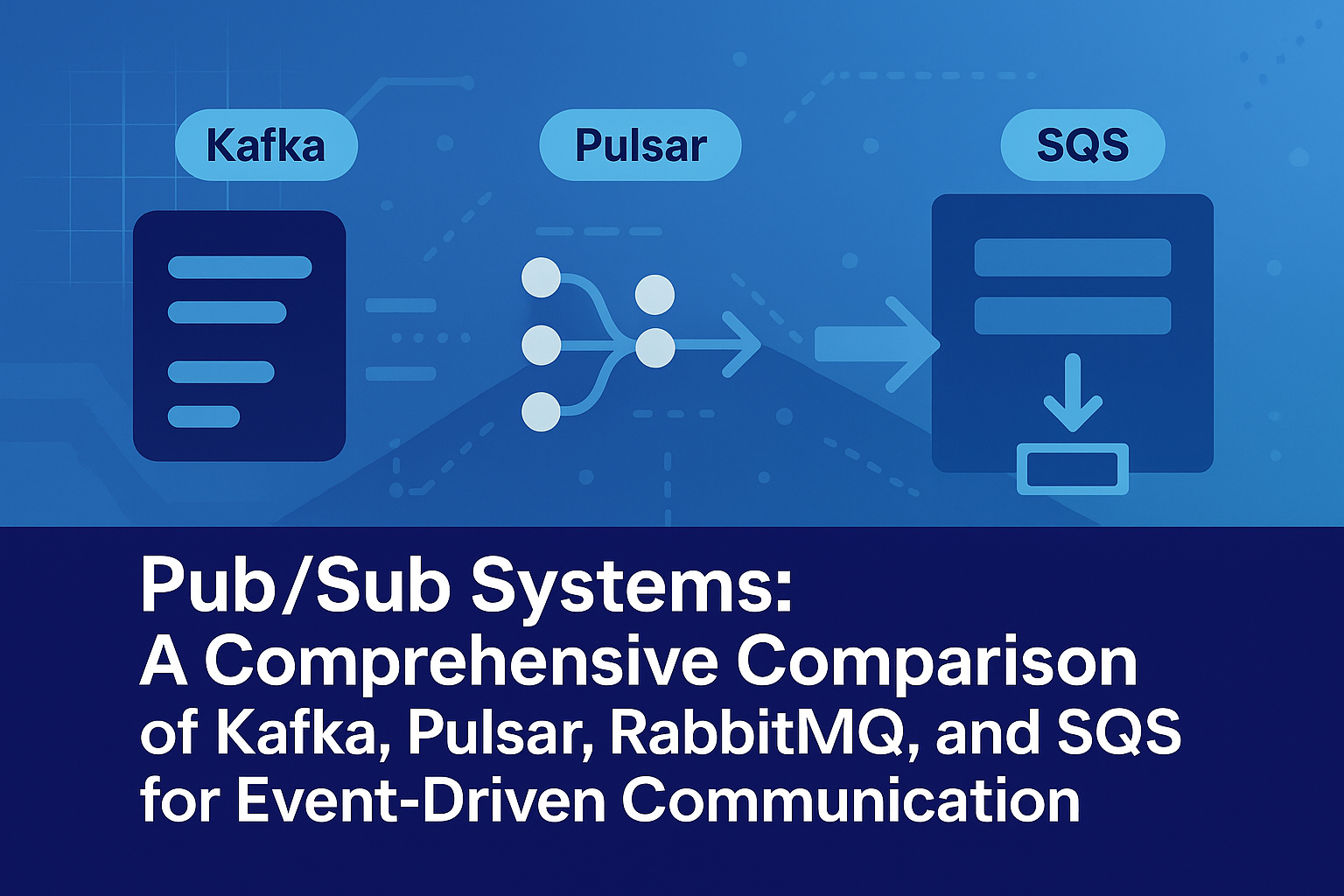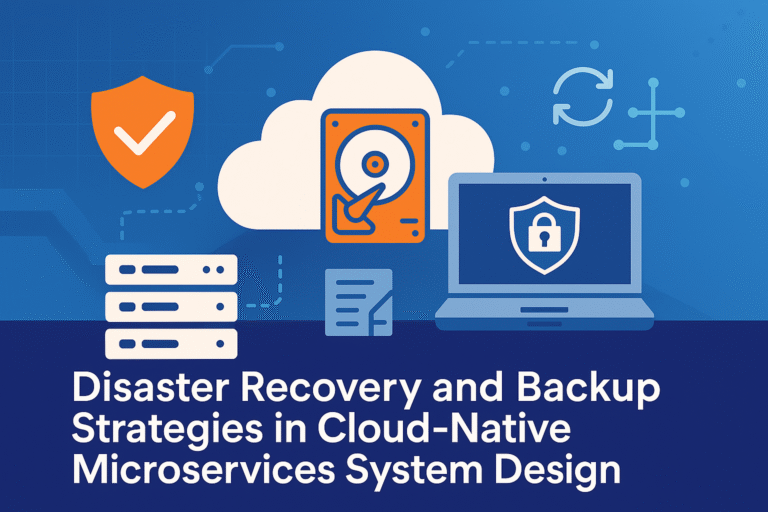Introduction
Publish-Subscribe (Pub/Sub) systems are a cornerstone of event-driven architectures, enabling asynchronous communication between producers (who publish messages) and consumers (who subscribe to messages) through a broker. These systems decouple components, facilitating scalability, fault tolerance, and real-time data processing in distributed environments. Pub/Sub is ideal for applications requiring high-throughput event streaming, such as IoT, financial trading, or analytics pipelines. This analysis compares four prominent Pub/Sub systems—Apache Kafka, Apache Pulsar, RabbitMQ, and Amazon Simple Queue Service (SQS)—focusing on their mechanisms, performance, use cases, advantages, limitations, and trade-offs, particularly for event-driven communication. It integrates prior concepts such as the CAP Theorem (prioritizing availability and partition tolerance), consistency models (eventual vs. strong consistency), consistent hashing (for message distribution), idempotency (for safe retries), unique IDs (e.g., Snowflake for message tracking), heartbeats (for liveness), failure handling (e.g., retries, dead-letter queues), single points of failure (SPOFs) avoidance, checksums (for integrity), GeoHashing (for location-based routing), rate limiting (to control message flow), Change Data Capture (CDC) (for database integration), load balancing (for consumer scaling), quorum consensus (for coordination), multi-region deployments (for global access), and capacity planning (for resource allocation). The discussion provides a structured framework for system architects, emphasizing scalability, performance, and strategic considerations for event-driven systems.
Mechanisms of Pub/Sub Systems
Core Concepts of Pub/Sub
In a Pub/Sub system:
- Producers publish messages to a logical channel (e.g., topic or queue).
- Brokers store and route messages to subscribers, ensuring durability and scalability.
- Consumers subscribe to channels, processing messages asynchronously.
- Message Delivery: Supports at-least-once, at-most-once, or exactly-once semantics, depending on the system.
Key mechanisms include:
- Message Routing: Uses consistent hashing for partitioning (e.g., Kafka, Pulsar) or queue-based routing (e.g., RabbitMQ, SQS).
- Durability: Messages are persisted (e.g., Kafka logs, SQS queues) with configurable retention.
- Scalability: Horizontal scaling via additional brokers or partitions.
- Fault Tolerance: Achieved through replication, heartbeats, and leader election.
Mathematical Foundation
- Throughput: Throughput = N × P × Tp, where N is brokers, P is partitions/queues, and Tp is throughput per partition/queue (e.g., 10 brokers × 50 partitions × 2,000 messages/s = 1M messages/s)
- Latency: Latency = produce_time + routing_time + consume_time (e.g., <10 ms end-to-end)
- Availability: 1 − (1 − broker_availability)R, where R is replication factor (e.g., 99.999% with 3 replicas at 99.9%)
- Lag: Lag = backlog / consume_rate (e.g., 1,000 messages / 10,000 messages/s = 0.1 s)
Comparison of Pub/Sub Systems: Kafka, Pulsar, RabbitMQ, SQS
Apache Kafka
Mechanism
Kafka is a distributed event streaming platform using a log-based architecture. Messages are published to topics, divided into partitions for parallel processing, and stored as immutable logs. Brokers manage partitions, with replication (e.g., factor 3) for durability. Consumers in groups process partitions concurrently, using offsets for tracking. KRaft provides quorum consensus for metadata, replacing ZooKeeper. Kafka Streams and Kafka Connect support processing and integration, with Schema Registry for schema management.
- Delivery Semantics: At-least-once by default, exactly-once with transactions.
- Routing: Consistent hashing for partitioning based on message keys (e.g., user_id).
- Durability: Configurable retention (e.g., 7 days), stored on disk.
- Fault Tolerance: Replication and leader election (KRaft, < 5s failover).
- Integration: CDC via Connect, GeoHashing for location-based routing, rate limiting via quotas.
Performance Metrics
- Throughput: 1M+ messages/s (10 brokers, 50 partitions).
- Latency: < 10ms local, 50–100ms multi-region.
- Availability: 99.999% with 3 replicas.
- Storage: 1TB/day for 1B messages at 1KB each (7-day retention = 7TB).
- Scalability: Linear via additional brokers/partitions.
Use Case: Real-Time Fraud Detection in Banking
- Context: A bank processes 500,000 transactions/day, needing instant fraud alerts.
- Implementation: Transactions published to a “transactions” topic with 20 partitions. Kafka Streams aggregates patterns (e.g., >5 transactions/min), using transactions for exactly-once semantics. Idempotency (Snowflake IDs) prevents duplicate alerts, rate limiting caps bursts (10,000 messages/s), and GeoHashing flags location anomalies. Multi-region replication ensures global access, with heartbeats for broker liveness and KRaft for coordination.
- Performance: < 10ms latency, 500,000 messages/s, 99.999% uptime.
- Advantages: High throughput, durable logs, scalable for peak loads.
- Limitations: Complex setup (10–15% DevOps overhead), eventual consistency (10–100ms lag).
Apache Pulsar
Mechanism
Pulsar is a multi-tenant, distributed Pub/Sub system with a segmented log architecture, separating storage (via Apache BookKeeper) from compute (brokers). Topics are divided into segments for scalability, with tiered storage offloading older data to cloud storage (e.g., S3). Consumers subscribe to topics or partitions, supporting exclusive, shared, or failover subscriptions. Pulsar Functions enable lightweight stream processing, and schema registry ensures compatibility.
- Delivery Semantics: At-least-once, exactly-once with transactions.
- Routing: Consistent hashing for segments, flexible subscription models.
- Durability: Configurable retention (e.g., infinite with tiered storage).
- Fault Tolerance: Replication in BookKeeper, quorum consensus for coordination.
- Integration: CDC via connectors, GeoHashing for routing, rate limiting per tenant.
Performance Metrics
- Throughput: 1M+ messages/s (10 brokers, 100 segments).
- Latency: < 10ms local, 50–100ms multi-region.
- Availability: 99.999% with 3 replicas.
- Storage: 1TB/day, offloaded to cloud for cost savings ($0.02/GB/month).
- Scalability: Linear via brokers or BookKeeper nodes.
Use Case: IoT Sensor Monitoring in Smart Cities
- Context: A city processes 1M sensor readings/s (e.g., traffic, air quality), needing real-time analytics.
- Implementation: Sensors publish to a “sensors” topic with 100 segments. Pulsar Functions aggregate data (e.g., pollution levels), with shared subscriptions for multiple consumers (e.g., traffic control, environmental monitoring). Tiered storage offloads historical data to S3, CDC integrates with databases, and GeoHashing routes by location. Multi-region replication supports global analytics, with heartbeats and quorum consensus ensuring reliability.
- Performance: < 10ms latency, 1M messages/s, 99.999% uptime.
- Advantages: Multi-tenancy, cost-effective storage, flexible subscriptions.
- Limitations: Higher complexity than Kafka, newer ecosystem.
RabbitMQ
Mechanism
RabbitMQ is a traditional message broker using a queue-based architecture. Producers publish to exchanges, which route messages to queues based on rules (e.g., direct, topic, fanout). Consumers pull messages from queues, with manual or automatic acknowledgment. Clustering and mirrored queues provide fault tolerance, but scalability is limited compared to log-based systems.
- Delivery Semantics: At-least-once, at-most-once, no native exactly-once.
- Routing: Exchange-based (e.g., topic exchange for pattern matching).
- Durability: Persistent queues, configurable retention.
- Fault Tolerance: Mirrored queues, leader election via clustering.
- Integration: Plugins for CDC, rate limiting via configuration, no native GeoHashing.
Performance Metrics
- Throughput: 100,000 messages/s (5 nodes, multiple queues).
- Latency: < 20ms local, 100–200ms multi-region.
- Availability: 99.99% with mirrored queues.
- Storage: 100GB/day for 100M messages at 1KB each.
- Scalability: Limited by cluster size (e.g., 10 nodes max).
Use Case: Task Queuing in E-Commerce Order Processing
- Context: An e-commerce platform processes 50,000 orders/day, needing reliable task distribution.
- Implementation: Orders published to a “orders” exchange, routed to queues (e.g., “payment”, “inventory”) via direct exchange. Consumers process tasks (e.g., payment validation), with acknowledgments for reliability. Idempotency ensures safe retries, rate limiting caps bursts, and heartbeats monitor consumers. Clustering provides fault tolerance, but lacks multi-region replication.
- Performance: < 20ms latency, 50,000 messages/s, 99.99% uptime.
- Advantages: Simple setup, flexible routing, mature ecosystem.
- Limitations: Limited scalability, no native exactly-once, higher latency.
Amazon SQS
Mechanism
Amazon SQS is a fully managed, serverless message queue service in AWS. Producers send messages to queues (standard or FIFO), and consumers poll messages. Standard queues prioritize throughput, while FIFO ensures ordering and exactly-once delivery. SQS integrates with AWS services (e.g., Lambda, SNS) for serverless workflows.
- Delivery Semantics: At-least-once for standard, exactly-once for FIFO.
- Routing: Queue-based, no partitioning.
- Durability: Messages stored in AWS infrastructure (retention up to 14 days).
- Fault Tolerance: Managed by AWS, no SPOFs.
- Integration: Native AWS integration, rate limiting via throttling, no native GeoHashing or CDC.
Performance Metrics
- Throughput: 100,000+ messages/s for standard queues, 3,000 messages/s for FIFO.
- Latency: < 20ms local, 100–200ms cross-region.
- Availability: 99.99% (AWS SLA).
- Storage: Minimal, capped at 14 days.
- Scalability: Virtually unlimited (serverless).
Use Case: Serverless Workflow in Video Streaming
- Context: A streaming platform triggers 100,000 video transcoding tasks/day.
- Implementation: Tasks published to an SQS queue, consumed by Lambda functions for transcoding. Idempotency ensures safe retries, rate limiting (AWS throttling) caps requests, and CDC logs task events to DynamoDB. Multi-region queues support global access, with AWS-managed fault tolerance.
- Performance: < 20ms latency, 100,000 messages/s, 99.99% uptime.
- Advantages: Serverless simplicity, high availability, AWS integration.
- Limitations: Limited control, higher cost ($0.40/M requests), no native stream processing.
Comparison Table
| Aspect | Kafka | Pulsar | RabbitMQ | SQS |
| Architecture | Log-based, partitioned topics | Segmented logs, tiered storage | Queue-based, exchanges | Queue-based, serverless |
| Delivery Semantics | At-least-once, exactly-once | At-least-once, exactly-once | At-least-once, at-most-once | At-least-once, exactly-once (FIFO) |
| Throughput | 1M+ messages/s | 1M+ messages/s | 100,000 messages/s | 100,000+ (standard), 3,000 (FIFO) |
| Latency | < 10ms | < 10ms | < 20ms | < 20ms |
| Availability | 99.999% (3 replicas) | 99.999% (3 replicas) | 99.99% (mirrored queues) | 99.99% (AWS SLA) |
| Scalability | Linear (brokers/partitions) | Linear (brokers/segments) | Limited (cluster size) | Unlimited (serverless) |
| Durability | Configurable retention (7 days) | Infinite (tiered storage) | Configurable | 14 days max |
| Complexity | High (DevOps overhead) | High (newer ecosystem) | Moderate | Low (managed) |
| Cost | $0.05/GB/month (self-hosted) | $0.02/GB/month (tiered) | $0.05/GB/month | $0.40/M requests |
Advantages and Limitations
Kafka:
- Advantages: High throughput, durable logs, rich ecosystem (Streams, Connect), multi-region support.
- Limitations: Complex setup, eventual consistency, storage costs.
Pulsar:
- Advantages: Multi-tenancy, tiered storage, flexible subscriptions, exactly-once support.
- Limitations: Higher complexity, less mature than Kafka.
RabbitMQ:
- Advantages: Simple setup, flexible routing, mature for queue-based tasks.
- Limitations: Limited scalability, no native exactly-once, higher latency.
SQS:
- Advantages: Serverless, high availability, seamless AWS integration.
- Limitations: Limited control, higher cost, no native stream processing.
Trade-Offs and Strategic Considerations
- Throughput vs. Latency:
- Trade-Off: Kafka/Pulsar prioritize throughput (1M/s) with low latency (< 10ms); RabbitMQ/SQS trade lower throughput for simplicity.
- Decision: Use Kafka/Pulsar for high-volume streaming, RabbitMQ/SQS for simpler tasks.
- Interview Strategy: Justify Kafka for IoT, SQS for serverless.
- Consistency vs. Availability:
- Trade-Off: Kafka/Pulsar favor AP with eventual consistency (10–100ms lag); RabbitMQ/SQS offer stronger consistency but limited scale.
- Decision: Use Kafka/Pulsar for high-availability streams, RabbitMQ for consistent tasks.
- Interview Strategy: Propose Kafka for banking fraud, RabbitMQ for order processing.
- Scalability vs. Complexity:
- Trade-Off: Kafka/Pulsar scale linearly but require DevOps (10–15% overhead); SQS is simple but costly.
- Decision: Use Kafka/Pulsar for large-scale systems, SQS for serverless.
- Interview Strategy: Highlight Pulsar for multi-tenant IoT, SQS for AWS workflows.
- Cost vs. Control:
- Trade-Off: Kafka/Pulsar (self-hosted) offer control but increase costs ($0.05/GB/month); SQS is managed but expensive ($0.40/M requests).
- Decision: Use Kafka/Pulsar for cost-sensitive apps, SQS for rapid deployment.
- Interview Strategy: Justify Kafka for cost-efficient analytics, SQS for startups.
- Durability vs. Storage:
- Trade-Off: Kafka/Pulsar support long retention (7+ days) but increase storage; SQS/RabbitMQ have shorter retention.
- Decision: Use Kafka/Pulsar for durable streams, RabbitMQ/SQS for transient tasks.
- Interview Strategy: Propose Pulsar for infinite retention, SQS for short-term.
Advanced Implementation Considerations
- Deployment: Kafka/Pulsar on Kubernetes with 10 brokers, RabbitMQ on clusters, SQS serverless.
- Configuration:
- Kafka: 50 partitions, 3 replicas, 7-day retention.
- Pulsar: 100 segments, tiered storage to S3.
- RabbitMQ: Mirrored queues, 5 nodes.
- SQS: Standard or FIFO queues, 14-day retention.
- Performance Optimization:
- Use SSDs for Kafka/Pulsar (< 1ms I/O).
- Enable GZIP compression (50–70% network reduction).
- Cache offsets in Redis (< 0.5ms access).
- Monitoring:
- Track throughput (1M/s), latency (< 10ms), lag (< 100ms) with Prometheus/Grafana.
- Monitor resource usage (> 80% alerts) via CloudWatch.
- Security:
- Encrypt messages with TLS 1.3.
- Use IAM/RBAC for access.
- Verify integrity with SHA-256 checksums.
- Testing:
- Stress-test with JMeter (1M messages/s).
- Validate failover (< 5s) with Chaos Monkey.
- Test split-brain scenarios.
Discussing in System Design Interviews
- Clarify Requirements:
- Ask: “What’s the throughput (1M messages/s)? Latency (< 10ms)? Retention (7 days)? Managed or self-hosted?”
- Example: Confirm 1M messages/s for IoT streaming.
- Propose System:
- Kafka: High-throughput streaming (e.g., fraud detection).
- Pulsar: Multi-tenant streaming (e.g., smart cities).
- RabbitMQ: Task queuing (e.g., e-commerce orders).
- SQS: Serverless workflows (e.g., video transcoding).
- Example: “For IoT, use Pulsar with tiered storage.”
- Address Trade-Offs:
- Explain: “Kafka scales but is complex; SQS is simple but costly.”
- Example: “Use Kafka for banking, SQS for serverless.”
- Optimize and Monitor:
- Propose: “Use partitioning for throughput, monitor lag with Prometheus.”
- Example: “Track fraud detection latency.”
- Handle Edge Cases:
- Discuss: “Mitigate lag with more partitions, use DLQs for failures.”
- Example: “For IoT, use DLQs for failed sensor events.”
- Iterate Based on Feedback:
- Adapt: “If cost is key, use Pulsar; if simplicity, use SQS.”
- Example: “For startups, switch to SQS.”
Conclusion
Kafka, Pulsar, RabbitMQ, and SQS are powerful Pub/Sub systems for event-driven communication, each excelling in specific scenarios. Kafka and Pulsar offer unmatched throughput (1M+ messages/s) and scalability for streaming, Pulsar adds multi-tenancy and tiered storage, RabbitMQ suits simpler task queuing, and SQS provides serverless ease. Integration with concepts like CDC, quorum consensus, and multi-region replication enhances their robustness, while trade-offs like complexity vs. scalability guide selection. Real-world examples in banking, IoT, e-commerce, and streaming illustrate their versatility. By aligning with workload requirements and monitoring metrics, architects can design scalable, resilient event-driven systems.




